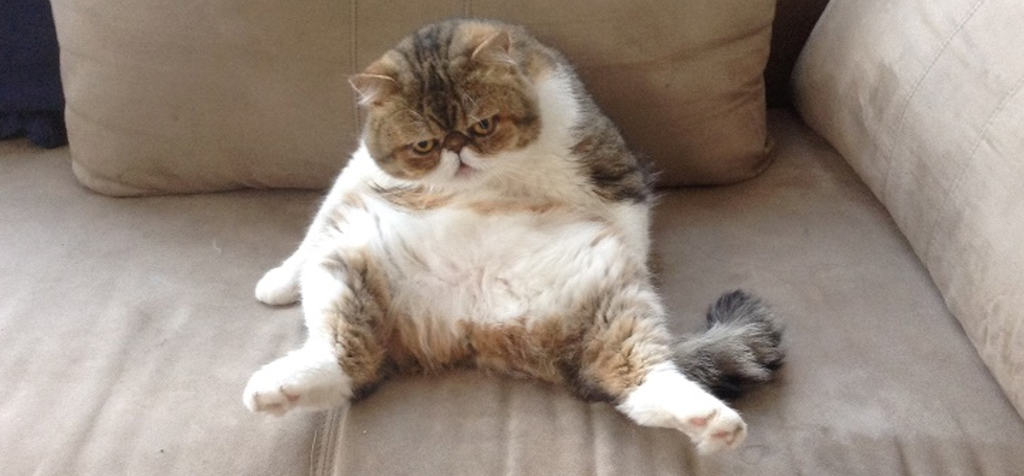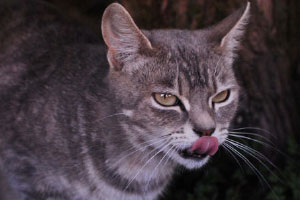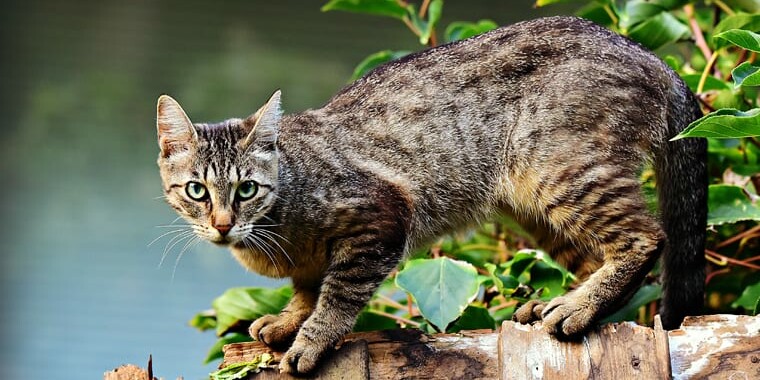By Tida Nou
This is not my cat, but one I’m very fond of (even with my cat allergy).
Leo loves sleeping, sometimes in inexplicably strange, seemingly uncomfortable positions. When I visit, he purrs incessantly, looks at me with adoring eyes, and insists on sitting on my lap and leaving copious amounts of cat fur all over me.
Looking at him, you would be forgiven for thinking he has a Garfield-type diet of lasagne, donuts and pizza. His skills at chasing foam darts shot out of a Nerf blaster are quite remarkable. In spite of his rotundness, he can sprint across the wooden floorboards that line his home and pounce on a Nerf dart with surprising force. He’s quite impressive.
And don’t be fooled by his slightly grouchy face. Leo is a healthy, safe and contented indoors cat, and an adored family member.

Are indoor cats happier cats?
Researchers at the Threatened Species Recovery Hub recently led an analysis of the impact of pet cats in Australia (download the fact sheet).
They found that 71% of pet cats (2.7 million), are allowed to roam and hunt.
This is bad news for our wildlife – pet cats number among the many threats facing Australia’s unique urban wildlife and in some cases they are driving declines in native species populations.
When pet cats are not desexed, they also breed, contributing to an unknown, but preventable, level of transfer to stray cat populations. There is a widespread misconception that keeping cats well fed, and inside at night will prevent them hunting but unfortunately, this is not the case.
A recent survey of local governments in Australia, which have an important role in managing pet and stray cat populations, revealed concerns that there is a rather detached approach among some cat owners about how they care for their cats. Because cats can be obtained freely or cheaply, some cat owners are reluctant to cover the costs of desexing, registration, microchipping, and veterinary care, because in the event of misfortune, their pet cat is readily replaced.
Animal shelters and workers face huge challenges in dealing with lost cats, relinquished cats, unwanted litters, stray cats and dumped cats. There is also a typically much lower reclaim rate for lost cats than for dogs that have strayed from home.
50,000 cats and counting
There is no centralised source of information for cat impoundment rates nationally, but an RSPCA report from a subset of shelters shows that at least 50,000 cats are impounded every year. The real figure – which would also include council and independent shelters – is likely to be substantially higher.
Clearly, there is an ongoing sad and vicious cycle of pet cat over-population, over-crowded animal shelters, and high euthanasia rates for cats in Australia.
This is a complex, nuanced and vexed issue. But, we can and should do better, and part of this requires a shift in the way we value and manage pet cats.
All your loving
We increasingly hear the phrase ‘responsible pet ownership’, but what does this mean for pet cat owners?
The key action cat owners can take is to securely contain their cats at all times, and ensure they are desexed (as well as registered and microchipped, where required). There are resources available for owners interested in cat containment, or transitioning them from an outdoors to an indoors pet.
Indoor cats are much safer from a myriad of threats, including cars, poisoning, and exposure to infections and parasitic diseases. Indoor cats are also much safer from less commonly encountered, but still deadly, threats: snakes, traps and baits as well as foxes, just to name a few.
The Australian Veterinary Association states that “the more time a pet cat spends safe at home, the less risk of injury or death from road accidents, fighting and disease. A pet cat kept safe at home can live up to four times longer than a cat left to roam.”
Every single pet cat kept securely contained will help our urban wildlife, including our colourful garden birds, blue tongue lizards and bandicoots. And they will be a safer, happier cat.
So what are you waiting for? Time to give your cat all your loving.



